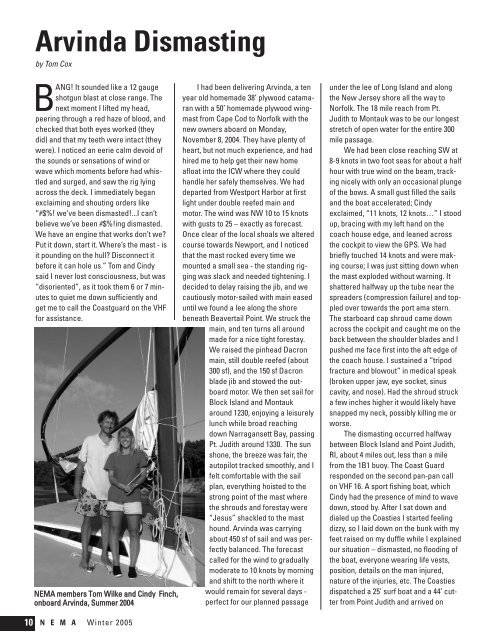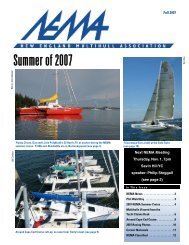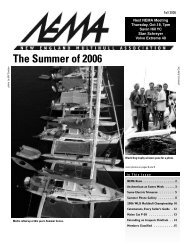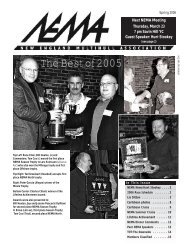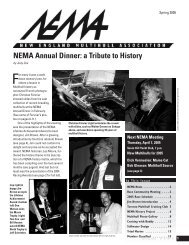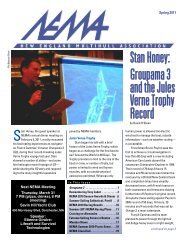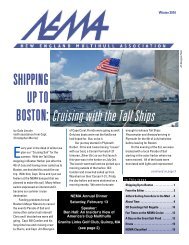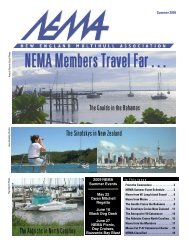Winter 2005 - New England Multihull Association
Winter 2005 - New England Multihull Association
Winter 2005 - New England Multihull Association
Create successful ePaper yourself
Turn your PDF publications into a flip-book with our unique Google optimized e-Paper software.
Arvinda Dismasting<br />
by Tom Cox<br />
BANG! It sounded like a 12 gauge<br />
shotgun blast at close range. The<br />
next moment I lifted my head,<br />
peering through a red haze of blood, and<br />
checked that both eyes worked (they<br />
did) and that my teeth were intact (they<br />
were). I noticed an eerie calm devoid of<br />
the sounds or sensations of wind or<br />
wave which moments before had whistled<br />
and surged, and saw the rig lying<br />
across the deck. I immediately began<br />
exclaiming and shouting orders like<br />
“#$%! we’ve been dismasted!...I can’t<br />
believe we’ve been #$%!ing dismasted.<br />
We have an engine that works don’t we?<br />
Put it down, start it. Where’s the mast - is<br />
it pounding on the hull? Disconnect it<br />
before it can hole us.” Tom and Cindy<br />
said I never lost consciousness, but was<br />
“disoriented”, as it took them 6 or 7 minutes<br />
to quiet me down sufficiently and<br />
get me to call the Coastguard on the VHF<br />
for assistance.<br />
NEMA members Tom Wilke and Cindy Finch,<br />
onboard Arvinda, Summer 2004<br />
I had been delivering Arvinda, a ten<br />
year old homemade 38’ plywood catamaran<br />
with a 50’ homemade plywood wingmast<br />
from Cape Cod to Norfolk with the<br />
new owners aboard on Monday,<br />
November 8, 2004. They have plenty of<br />
heart, but not much experience, and had<br />
hired me to help get their new home<br />
afloat into the ICW where they could<br />
handle her safely themselves. We had<br />
departed from Westport Harbor at first<br />
light under double reefed main and<br />
motor. The wind was NW 10 to 15 knots<br />
with gusts to 25 – exactly as forecast.<br />
Once clear of the local shoals we altered<br />
course towards <strong>New</strong>port, and I noticed<br />
that the mast rocked every time we<br />
mounted a small sea - the standing rigging<br />
was slack and needed tightening. I<br />
decided to delay raising the jib, and we<br />
cautiously motor-sailed with main eased<br />
until we found a lee along the shore<br />
beneath Beavertail Point. We struck the<br />
main, and ten turns all around<br />
made for a nice tight forestay.<br />
We raised the pinhead Dacron<br />
main, still double reefed (about<br />
300 sf), and the 150 sf Dacron<br />
blade jib and stowed the outboard<br />
motor. We then set sail for<br />
Block Island and Montauk<br />
around 1230, enjoying a leisurely<br />
lunch while broad reaching<br />
down Narragansett Bay, passing<br />
Pt. Judith around 1330. The sun<br />
shone, the breeze was fair, the<br />
autopilot tracked smoothly, and I<br />
felt comfortable with the sail<br />
plan, everything hoisted to the<br />
strong point of the mast where<br />
the shrouds and forestay were<br />
“Jesus” shackled to the mast<br />
hound. Arvinda was carrying<br />
about 450 sf of sail and was perfectly<br />
balanced. The forecast<br />
called for the wind to gradually<br />
moderate to 10 knots by morning<br />
and shift to the north where it<br />
would remain for several days -<br />
perfect for our planned passage<br />
under the lee of Long Island and along<br />
the <strong>New</strong> Jersey shore all the way to<br />
Norfolk. The 18 mile reach from Pt.<br />
Judith to Montauk was to be our longest<br />
stretch of open water for the entire 300<br />
mile passage.<br />
We had been close reaching SW at<br />
8-9 knots in two foot seas for about a half<br />
hour with true wind on the beam, tracking<br />
nicely with only an occasional plunge<br />
of the bows. A small gust filled the sails<br />
and the boat accelerated; Cindy<br />
exclaimed, “11 knots, 12 knots…” I stood<br />
up, bracing with my left hand on the<br />
coach house edge, and leaned across<br />
the cockpit to view the GPS. We had<br />
briefly touched 14 knots and were making<br />
course; I was just sitting down when<br />
the mast exploded without warning. It<br />
shattered halfway up the tube near the<br />
spreaders (compression failure) and toppled<br />
over towards the port ama stern.<br />
The starboard cap shroud came down<br />
across the cockpit and caught me on the<br />
back between the shoulder blades and I<br />
pushed me face first into the aft edge of<br />
the coach house. I sustained a “tripod<br />
fracture and blowout” in medical speak<br />
(broken upper jaw, eye socket, sinus<br />
cavity, and nose). Had the shroud struck<br />
a few inches higher it would likely have<br />
snapped my neck, possibly killing me or<br />
worse.<br />
The dismasting occurred halfway<br />
between Block Island and Point Judith,<br />
RI, about 4 miles out, less than a mile<br />
from the 1B1 buoy. The Coast Guard<br />
responded on the second pan-pan call<br />
on VHF 16. A sport fishing boat, which<br />
Cindy had the presence of mind to wave<br />
down, stood by. After I sat down and<br />
dialed up the Coasties I started feeling<br />
dizzy, so I laid down on the bunk with my<br />
feet raised on my duffle while I explained<br />
our situation – dismasted, no flooding of<br />
the boat, everyone wearing life vests,<br />
position, details on the man injured,<br />
nature of the injuries, etc. The Coasties<br />
dispatched a 25’ surf boat and a 44’ cutter<br />
from Point Judith and arrived on<br />
10<br />
N E M A <strong>Winter</strong> <strong>2005</strong>


